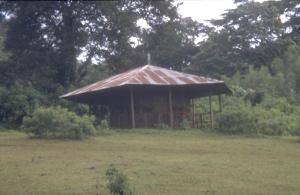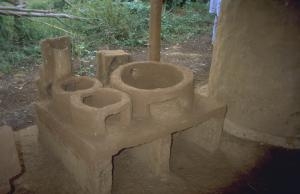Dr. Efraim Mammo, the former chancellor of the Alemaya University (in Harrar), whom Getinet knows from his period there, is from Dembi Dolo and has returned there after retiring some five years ago when he had reached the retirement age of the civil service, 55. Only full professors have no obligatory retirement age. He was a specialist for livestock management and now practices here as a veterinarian.
In the afternoon he shows us Dembi Dolo (see map 10).
Map 10: Dembi Dolo and surroundings (waypoints 029 - 035, 062 - 067)

Move mouse over the waypoints to see GPS coordinates.
|
Waypoint 062 | Lat. 8° 31′ 56.07″ N / Long. 34° 47′ 56.31″ E Dembi Dolo. Berhane Hotel |
|
Waypoint 063 | Lat. 8° 31′ 17.64″ N / Long. 34° 47′ 57.17″ E Left: Administrator’s residence; right: prison |
|
Waypoint 064 | Lat. 8° 30′ 39.28″ N / Long. 34° 47′ 57.67″ E Bethel Evangelical Secondary School, run by Mekane Yesus. There are some foreign teachers from Finland and the U.S. |
|
Waypoint 065 | Lat. 8° 31′ 42.36″ N / Long. 34° 47′ 27.85″ E Photographs: abandoned mosque; views of the landscape |

|

|
Move mouse over pictures to see a larger version with captions
|
Waypoint 066 | Lat. 8° 31′ 19.93″ N / Long. 34° 45′ 26.64″ E Addo Catholic Mission (photographs). Father Petros, a Dutchman who has been here for 35 years, shows us the Applied Technology Workshop. This mission is where Lambert Bartels, author of Oromo Religion (1983), worked. Further photographs: mud ovens; mud blocks; bee hives of mud. |

|

|
Move mouse over pictures to see a larger version with captions
|
Waypoint 067 | Lat. 8° 32′ 37.59″ N / Long. 34° 47′ 54.62″ E Public Recreation Centre. Pavillion. Garden with labyrinth made of hedges. Dr. Efraim explains that is was built by the Derg. At that time, a very lively place. Now privatised but not profitable. There is no buying power in the region, and even if more attractions, such as concerts or other performances, were organised, there would be no financial basis for adequate demand for it. Photographs: large old trees; Colobus monkeys. Just before one reaches the Public Recreation Centre, the Seventh Day Adventist Church is on the right. |
Dr. Efraim has a very negative view of the economic development of Dembi Dolo. It is an ecologically favoured area, but nevertheless there is much poverty. Whoever can afford to leave, does so. People migrate to the greater Addis Ababa area, to places such as Debre Zeyt/Bishoftu.
He calls the mission churches "the only things which are alive in the area". He accuses government institutions of mismanagement. The public veterinary service is constantly short of drugs. People are sent to him, a private veterinarian, with prescriptions by the public veterinarians, because the state cannot provide the drugs it prescribes.
The receptionist at the Berhane Hotel, Gamachu, says that five to six years ago there were some Mbororo who stayed in the Dembi Dolo area for about a year (!). They had come from the north-east along the main road and then were said to have moved on to Gambella via Muggi. They used to sell milk and oxen for slaughter. Dr. Efraim had said that it is difficult to buy milk around here, in spite of the rural character of Dembi Dolo and even though many people keep cows, even in town. This may explain why the milk offered for sale by the Mbororo was in demand; but both Gashaw and Ambissa said that in Muggi and Shabal people were afraid of buying milk from the Mbororo because they suspected them of practising magic.
